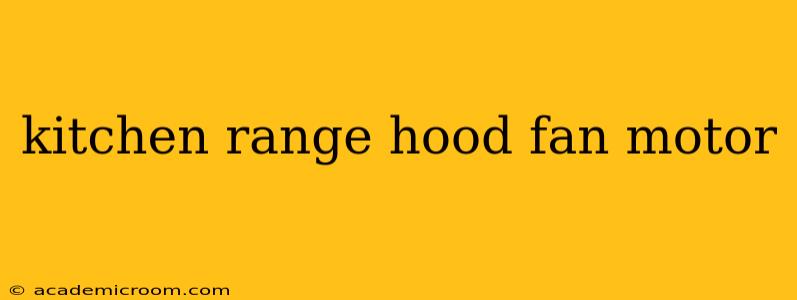A kitchen range hood, or extractor fan, is a crucial appliance for maintaining a clean and healthy cooking environment. At the heart of its functionality lies the range hood fan motor, a component often overlooked until it malfunctions. Understanding the range hood fan motor – its types, troubleshooting, and maintenance – is essential for keeping your kitchen efficient and safe. This guide will delve into the intricacies of this often-unsung hero of your kitchen.
What are the Different Types of Kitchen Range Hood Fan Motors?
Range hood fan motors come in several varieties, each with its own strengths and weaknesses. The choice often depends on the hood's design and desired performance level.
-
AC (Alternating Current) Motors: These are the most common type found in many standard range hoods. They're generally more affordable and readily available. However, they tend to be less energy-efficient and potentially noisier than their DC counterparts.
-
DC (Direct Current) Motors: DC motors are becoming increasingly popular due to their superior energy efficiency and quieter operation. They offer more precise speed control and often come with features like electronic controls for smoother operation. However, they typically cost more upfront.
-
Brushless DC Motors: These are a type of DC motor that offer even greater efficiency and longevity than brushed DC motors. They are quieter and tend to last longer because they lack the brushes that wear out over time in brushed DC motors. This translates to a longer lifespan for the entire range hood.
How Does a Kitchen Range Hood Fan Motor Work?
The range hood fan motor's primary function is to power the fan blades, creating the suction that removes cooking fumes, smoke, grease, and odors from the air. The motor's speed determines the intensity of the suction. Different motors achieve this through various mechanisms, but the underlying principle remains the same: converting electrical energy into mechanical energy to rotate the fan blades.
How to Troubleshoot a Kitchen Range Hood Fan Motor?
A malfunctioning range hood fan motor can be a significant inconvenience. Here are some common problems and troubleshooting steps:
The Range Hood Fan Isn't Working at All:
- Check the power supply: Ensure the range hood is properly plugged in and the circuit breaker hasn't tripped.
- Examine the fuse or circuit breaker: A blown fuse or tripped breaker could be interrupting the power flow.
- Inspect the motor: Look for any visible damage to the motor or its wiring. This may require some disassembly, so consult your range hood's manual or a qualified technician if you are uncomfortable with this step.
- Check the switch: Make sure the switch on the range hood and any wall-mounted switches controlling the power are functioning correctly.
The Range Hood Fan is Making Strange Noises:
Unusual noises often indicate a problem with the motor bearings or other internal components.
- Listen carefully: Identify the type of noise (grinding, whining, clicking). This can help diagnose the issue.
- Check for obstructions: Ensure nothing is blocking the fan blades or motor.
- Look for loose parts: If you're comfortable doing so, carefully inspect the motor for any loose screws or parts that might be causing vibrations. If you find anything loose, carefully tighten it. If not, consult a professional.
The Range Hood Fan is Running Weakly:
- Check for filter clogs: A clogged grease filter can significantly reduce the fan's airflow. Clean or replace the filter as needed.
- Inspect the ductwork: Blockages in the ductwork can restrict airflow. Make sure the ductwork is clear and unobstructed.
How to Clean and Maintain a Kitchen Range Hood Fan Motor?
Regular cleaning and maintenance are crucial for extending the lifespan of your range hood fan motor. However, directly cleaning the motor itself is usually unnecessary and potentially harmful unless you're experienced with appliance repair. Focus your cleaning efforts on the areas you can easily access.
- Clean the grease filter regularly: This is arguably the most important maintenance task. Follow the manufacturer's instructions for cleaning or replacing the filter.
- Clean the exterior: Wipe down the exterior of the range hood regularly to remove grease buildup and other contaminants.
- Check the ductwork: Periodically inspect the ductwork for any buildup of grease or obstructions. Consult a professional for cleaning if needed.
How Long Does a Kitchen Range Hood Fan Motor Last?
The lifespan of a kitchen range hood fan motor varies depending on several factors, including the motor type, usage frequency, and maintenance. Generally, you can expect a well-maintained motor to last for several years. However, with regular use, the motor’s components will eventually wear out and require replacement.
Can I Replace a Kitchen Range Hood Fan Motor Myself?
Replacing a range hood fan motor is possible for some individuals with some DIY skills and knowledge of electrical work. However, if you're uncomfortable working with electricity or are unsure about any aspect of the process, it's best to contact a qualified appliance repair technician. Incorrect installation could lead to electrical hazards or further damage to the appliance.
This comprehensive guide offers a deeper understanding of your kitchen range hood fan motor, empowering you to maintain, troubleshoot, and extend its lifespan. Remember, regular maintenance is key to optimal performance and a long-lasting appliance.
